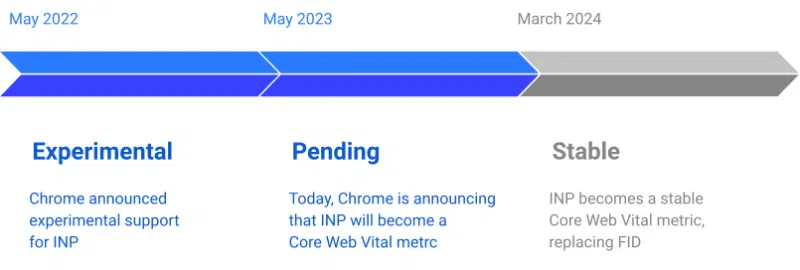

Last updated on

We now have the specific date when Google is set to replace First Input Delay (FID) with Interaction to Next Paint (INP) as a Core Web Vitals metric: March 12, 2024. The anticipation of INP taking over from FID had been known previously, with March as the expected transition month, but now we have the exact date.
Google made the official announcement on its Web.dev blog today, stating, “Today, we’re announcing that INP will officially become a Core Web Vital and replace FID on March 12 of this year, and that FID will be deprecated in this transition.” To emphasize the point, they reiterated, “INP will officially become a Core Web Vital and replace FID on March 12 of this year. Another outcome of this is that FID will no longer be a Core Web Vital and will be officially deprecated and removed from the program.”
But what exactly is Interaction to Next Paint (INP)? INP is a metric that utilizes data from the Event Timing API to evaluate a webpage’s responsiveness. It focuses on the latency of user interactions with the page. When an interaction causes the page to become unresponsive, it results in a subpar user experience. INP tracks the delay of all interactions a user makes with the page and provides a single value where nearly all interactions fall below a certain threshold.
Google even offered an example to illustrate the difference between poor and good responsiveness, emphasizing the importance of this metric in ensuring a smooth user experience.

On the left, extended tasks block the accordion’s ability to open smoothly. This can lead to users clicking multiple times, erroneously assuming that the experience is malfunctioning. Once the main thread catches up, it processes the delayed inputs, resulting in the accordion unexpectedly opening and closing.
What’s about to change is that Google will replace the FID metric with the INP metric as part of the Core Web Vitals, starting on March 12, 2024. In due course, Google Search Console will incorporate INP into the Core Web Vitals report, allowing you to begin measuring your new INP scores.
Once INP takes over from FID in March, the Google Search Console report will cease displaying FID metrics and will exclusively use INP from that point onward.

The reason why we should care about these changes is that many SEOs have dedicated a significant amount of time and effort to optimizing for Core Web Vitals and, specifically, the FID score. With the impending shift from FID to INP, these SEOs are likely to redirect their focus towards INP. Google has provided a guide on how to optimize for INP to help website owners adapt to this transition.
Fortunately, we’ve had some time to prepare for this change, as Google introduced the new INP reports in Search Console last year.
However, it’s important to keep things in perspective. While Core Web Vitals and metrics like FID and INP are important for assessing and improving page experience, they are just one piece of the puzzle. Google itself acknowledges that they should be considered in conjunction with other factors when striving to enhance your site’s overall user experience.
Ultimately, the user experience on your website can often be gauged simply by browsing it yourself to see how responsive and fast it is. You don’t always require third-party tools or obsess over scores to make excellent websites for your users.
So, it’s advisable to take a look at your INP score and identify if there are quick improvements you can make, but maintain a balanced approach without losing sight of the bigger picture of delivering a great user experience.
Original news from SearchEngineLand